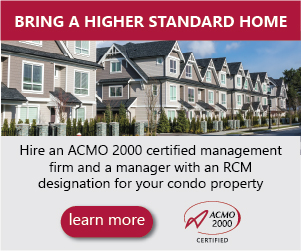Showing Articles from the category 'Feature'
Can Condos Deal with the Coming Reserve Fund Shock?
Managing New Builds vs. Old Condos
Feature || Nancy Longueira, Stefan Nespoli, Stephanie Robinson, Sally Thompson, Justin Tudor
Construction price inflation has been significantly higher than consumer inflation over the last three years. Reserve fund study updates completed this year and in 2024-2025 will have to reflect this significant increase in costs even for those projects that are in the distant future.
Important Legal Steps for New Condominiums
Managing New Builds vs. Old Condos
Feature || Joel Berkovitz, and Mohiminol Khandaker
Like newborn babies, a newly registered condominium corporation quickly goes through a number of developmental milestones on its way to becoming a fully functioning building. Many of these milestones occur within the one-year period following either registration or turnover. This article summarizes some of these key developments.
Is Networking Really Essential?
Profession Development for Managers
Feature || Sonia Ojha
The connections you make during a networking event will provide information, referrals, or opportunities for the future. Networking isn’t just crucial in today’s business world; it’s necessary!
Navigating Tarion & Warranty Protections for Condominium Common Elements
Managing New Builds vs. Old Condos
Feature || Ryan Haley
In Ontario, every new residential condominium built and sold comes with a seven-year warranty that starts on the condominium corporation’s registration date. For that reason, it is important for you as a condominium manager to be aware of the age of your condominium, as certain warranties and protection may still apply to the common elements.
New and Old, Different but the Same
Managing New Builds vs. Old Condos
Feature || Lyndsey McNally
Despite the age of a condominium corporation, the common issue is that financial shortfalls directly affect the individual owners within the community. When inflation and interest rates surpass income growth for most individuals, overcoming this challenge is more difficult.
The Challenges & Rewards of Managing Aging Townhome Communities
Managing New Builds vs. Old Condos
Feature || Thomas Kortko, RCM
When older communities were constructed, they did not benefit from the decades of cumulative condominium experience that we have access to now. It was indeed the “wild west,” with the first corporations, boards and various industry professionals planning a future with limited experience and few points of reference.
The Differences Between Managing New & Old Condominiums
Managing New Builds vs. Old Condos
Feature || John Damaren, RCM
While there are certainly differences in managing older housing stock vs. new, there are also many similarities. The life cycle of a condominium corporation comes with unique challenges in managing each stage.
The End of the Line: The Termination of a Condominium Corporation
Managing New Builds vs. Old Condos
Feature || Denise Lash
As condominium buildings age and land values continue to escalate, some condominium corporations are now considering the possibility of selling all the units and common elements of their condominium site when approached by condo developers with an agreement of purchase and sale.
Today’s Actions are Tomorrow’s Results
Managing New Builds vs. Old Condos
Feature || Thomas Inrig, RCM
Long-term performance, efficiency and the overall quality of a condominium strongly correlate with specific actions and procedures put in place early in a building’s life. From inception, a condominium must be guided in the right direction, and its future market value may be traced back to the actions taken or not taken during the pre-turnover period and the first couple of years following registration.
Avoiding Major Construction Pitfalls
Managing Contractors, Suppliers & Expectations
Feature || Patrick Cutten
A well-executed construction project is a result of strong collaboration between the engineering consultant, the property manager, the board, and the contractor. This article discusses how to avoid common pitfalls.
Capital Projects vs Repairs & Maintenance
Managing Contractors, Suppliers & Expectations
Feature || Van Smith, RCM
Ask a property manager to explain what takes up most of their busy workday, and they will probably respond with a list of maintenance items. Most of a condominium manager’s time in any given week is spent working on the maintenance and repair of the condominium structure, equipment, and site. This includes preparation for scheduled items or dealing with those unscheduled emergencies on a Monday morning. So, where does a capital project fit into a manager’s work week?
Dear ACMO
Managing Contractors, Suppliers & Expectations
Feature || Response by Deborah Howden
An advice column where you can ask any question or share a difficult situation relating to condominium management anonymously, and we will endeavour to find an appropriate expert in the field and publish an answer with some advice. Ask the hard questions you may have been afraid to ask for fear of repercussions. Your full name or company will never be published or shared.
Managing Contractors, Suppliers & Expectations
Managing Contractors, Suppliers & Expectations
Feature || Laura Lee, RCM
Large or small, the use of contractors is inevitable in the day of a manager’s life. It is part of the manager’s job to ensure quality control and value for the condominium’s money, which is done by managing contractors/suppliers and setting expectations.
Procurement Best Practices
Managing Contractors, Suppliers & Expectations
Feature || Drew Harling, RCM
One of the most often talked about subjects in recent years is the topic of procurement processes. They vary from condo to condo, manager to manager, and management company to management company. Part of that is due to the very nature of condominiums. Individual condos have the decision-making responsibilities of what work will be done, who will do it, what vendors will be used and even what type of contract will be issued. These realities fly in the face of the systemic approach to procurement that most would want to see in our industry.
Seven Methods for Building Relationships with Residents
Managing Contractors, Suppliers & Expectations
Feature || Peter Pietrzkiewicz
Many moving parts need to be aligned to ensure everything in the residential community runs smoothly but the critical component is to have open two-way communication. But how do you achieve communication that results in high levels of trust, satisfaction, and engagement? How do you turn daily contact into stronger relationships?






